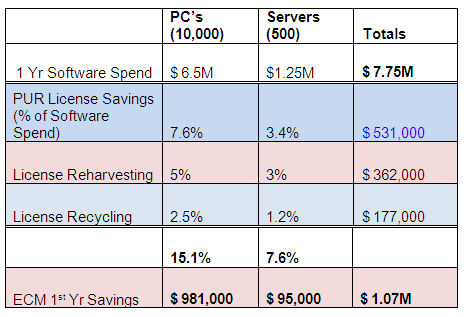Maximise Software Cost Savings By Applying Product Use Rights (Part 4/5)
 This article series has been contributed by John Emmitt at ManageSoft.
This article series has been contributed by John Emmitt at ManageSoft.
Software Asset Management (SAM) is a complex process that enables organizations to gain control of their software estate from both a license compliance and financial standpoint.
But, where do these cost savings come from? Reharvesting unused licenses and recycling licenses from retired hardware are techniques that yield significant savings. Another approach that is often overlooked is the application of product use rights (PUR) to reduce initial license purchase, true-up and renewal costs.
- Part 1 – License Agreements and Types
- Part 2 – Common Product Use Rights
- Part 3 – License Reharvesting & Recycling
- Part 4 – Sample Scenario
- Part 5 – SAM Automation
Part 4 – Sample Scenario
Let’s take the case of a hypothetical mid-sized insurance company that has the following IT hardware and software profile: 10,000 PC’s (desktops, laptops), 500 servers, and total software spend per year of $7.75 million ($23.25M over the three year term of their volume agreements). The annual software costs are allocated as shown in the table below, with $350 per PC and $1500 per server spent under MS EA, on average, $160 per PC and $200 per server under an MS Select Agreement, $50 per PC for Adobe applications, and so on.

Insurance Company IT Profile Showing Annual & 3 Year Software Spend
Now consider the cost savings that can be attained in year 1 by proper allocation of licenses based on PUR for PC licenses purchased under MS and Adobe volume agreements. Under MS Select agreements, as noted above, second use rights may be applied to all those users who have both a desktop and a laptop—let’s say only about 10% of the users fall into this category. Since MS Select PC spend is about 25% of the total, the potential savings is 2.5% (10% x 25%). If Adobe and other vendors account for another 14% of the PC spend for licenses that include second use rights, then an additional 1.4% (10% x 14%) savings is possible. This means that 3.9% of the PC software cost can be saved by correctly applying second use rights.
Multiple versions rights apply to MS EA and Select, as well as Adobe and some other vendor licenses. Another 3.7% savings can be achieved by applying the multiple versions right to PC software spend if we assume that only 4% of computers have multiple versions of software installed (4% x 94% = 3.7%). Total PUR savings is therefore 7.6% of the PC software budget. Similarly, multiple versions use rights could save an additional 3.4% of the server spend (4% of servers and let’s say 85% of software running on them allows this right).
If just 5% of users have unused software that can be re-harvested and an additional 10% of licenses from retired hardware can be recycled, that’s another 7.5% of the PC spend. (For example, if 25% of PCs are refreshed each year and 10% of software on those computers can be recycled then there is a 2.5% savings opportunity from recycling. 2.5% + 5% (for re-harvesting) = 7.5%).
Adding it all up (see table below), we find that about 15% of the PC software spend and about 7.6% of the server spend can be saved in the first year with an optimized SAM process using fairly conservative numbers. The result is $981,000 in potential savings on the PC software estate and about $95,000 on the server spend for a total first year cost savings of $1,070,000. Of this total, $531,000, or about half of the savings is attributable to proper application of PUR. So, it’s clear that PUR is a critical aspect of the SAM optimization process.

Total First Year Savings from Optimized SAM Program
Read Part Five – SAM Automation.
Related articles:
BANES Council forced to pay their Microsoft tax – or are they?
Ticketmaster data breach - "it wasn't me"
SaaS Application Management - should risk be prioritised over cost?
SaaS Applications – solving the Inventory & Discovery challenge
Open Source databases to cloud vendors – get forked!
Cybersecurity and unused Software
About Martin Thompson
Martin is also the founder of ITAM Forum, a not-for-profit trade body for the ITAM industry created to raise the profile of the profession and bring an organisational certification to market. On a voluntary basis Martin is a contributor to ISO WG21 which develops the ITAM International Standard ISO/IEC 19770.
He is also the author of the book "Practical ITAM - The essential guide for IT Asset Managers", a book that describes how to get started and make a difference in the field of IT Asset Management. In addition, Martin developed the PITAM training course and certification.
Prior to founding the ITAM Review in 2008 Martin worked for Centennial Software (Ivanti), Silicon Graphics, CA Technologies and Computer 2000 (Tech Data).
When not working, Martin likes to Ski, Hike, Motorbike and spend time with his young family.
Connect with Martin on LinkedIn.
